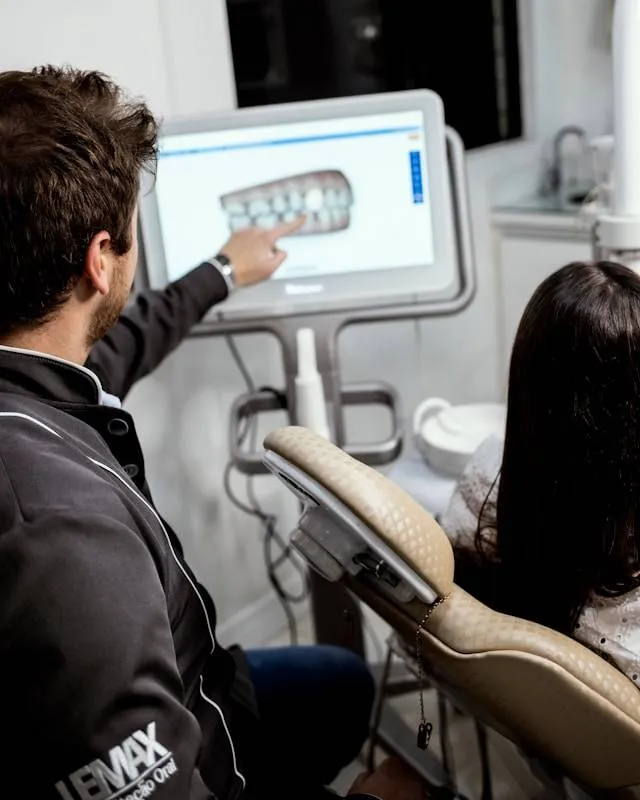1. What is a high-low side face?
Asymmetry is a facial asymmetry, where one side of the face tends to be higher or more developed than the other. This can affect the appearance and sometimes the function of the face.
When you have asymmetrical facial features, you may notice:
- One side of the face appears "fuller" than the other
- The chin tends to tilt to one side
- Asymmetrical lips when smiling
- Eyes may not be level
- One cheekbone is higher than the other
2. Causes of facial asymmetry
There are many causes that can lead to a face that is higher than one side and lower than the other:
a. Congenital genetics:
Sometimes, facial asymmetry can be a genetic trait inherited from your parents. If someone in your family has facial asymmetry, there is a high chance that you will also have this condition.
b. Bad habits:
- Chewing on one side: Regularly chewing food on only one side can cause uneven facial muscle development.
- Sleeping on your side: The habit of sleeping on one side for a long time can affect the facial bone structure.
- Poor posture: Constantly tilting your head or resting your chin on your hand can put uneven pressure on your face.
c. Injury:
Accidents or trauma to the face can alter bone and muscle structure.
d. Pathology:
- Sinusitis: Can cause swelling on one side of the face, creating a feeling of imbalance.
- Facial nerve palsy: Due to nerve damage, it can cause weakness or paralysis on one side of the face.
- Stroke or cerebrovascular accident: Can affect facial muscles and cause asymmetry.
e. Tooth loss:
Missing teeth on one side of the jaw can lead to uneven jaw development.
f. Malocclusion:
When teeth do not fit properly, it can cause facial imbalance.
g. Aging:
Over time, skin can sag unevenly, leading to facial imbalance.
3. Signs of facial asymmetry: one side is higher than the other
To recognize a face with one side higher than the other, you can observe the following signs:
- When you look straight into the mirror, you see that one side of your face appears "fuller" than the other.
- The midline of the upper front teeth is not aligned with the midline of the nose and chin.
- When smiling, one side of the lip tends to curl up higher than the other.
- One side of the jaw appears more defined than the other.
- Eyes may not be level.
- When chewing, you feel one side of your jaw working more than the other.
- One cheekbone appears higher or more prominent than the other.
4. The harmful effects of facial asymmetry
Asymmetrical facial features not only affect aesthetics but can also cause many health problems:
a. Psychological impact:
- Reduced confidence in communication
- Can lead to depression or anxiety about appearance
b. Problems with chewing and digestion:
- Difficulty chewing food
- Can lead to digestive problems due to poor chewing
c. Headache and muscle pain:
- Uneven muscle tension can cause headaches
- Pain in the jaw and face
d. Temporomandibular joint problems:
- May cause a clicking sound when opening the mouth
- Pain when chewing or talking
e. Effects on teeth:
- Uneven tooth wear
- Increased risk of tooth decay and gingivitis on the side that is chewed a lot
f. Difficulty in oral hygiene:
- Crooked teeth can be difficult to clean, increasing the risk of tooth decay
g. Effects on vision:
- If the eyes are not level, it can cause eye strain and headaches.
5. How to fix uneven face with one side higher than the other
a. Adjusting habits:
- Avoid sleeping on one side for too long
- Avoid resting your chin or head on your hand
- Practice chewing evenly on both sides.
b. Facial muscle training:
- Practice facial muscle exercises regularly
- Gently massage your face to stimulate blood circulation
c. Orthodontics:
- Braces can help correct the bite, thereby improving facial balance.
- In some cases, orthognathic surgery may be needed.
d. Dental treatment:
- Fillings or porcelain crowns to balance the bite
- Implant if tooth loss
e. Cosmetic surgery:
- In cases of severe facial asymmetry, cosmetic surgery may be considered.
- However, this is a last resort and should be considered carefully.
f. Physical therapy:
- Physical therapy exercises can help improve facial muscle balance.
- Neuromuscular stimulation techniques may be useful in some cases.
g. Using the trainer function:
- A trainer is a portable orthodontic device that can help guide the development of teeth and jawbones.
- Especially effective for children and adolescents
h. Treatment of underlying disease:
- If the facial deviation is due to a medical condition such as sinusitis or nerve paralysis, the underlying cause needs to be treated.
6. Preventing facial asymmetry
To prevent the condition of one side of the face being higher than the other, you can apply the following measures:
a. Maintain correct posture:
- Sit up straight, avoid tilting your head for too long
- When sleeping, try to lie on your back instead of on your side.
b. Dental care:
- Brush your teeth and floss regularly
- Dental check-up every 6 months
c. Practice chewing evenly on both sides:
- Be conscious of chewing and try to use both sides of your jaw.
d. Stress reduction:
- Stress can cause uneven facial muscle tension.
- Practice relaxation techniques like yoga or meditation
e. Avoid bad habits:
- Do not put pencils or other objects in your mouth.
- Avoid grinding your teeth or biting your nails
f. Balanced diet:
- Ensure adequate calcium and vitamin D supply for bone development
g. Protection when playing sports:
- Use mouth guards when participating in sports with a risk of collision.
7. When should I see a doctor?
You should see a doctor if:
- Notice a sudden change in facial symmetry
- Feeling pain or discomfort when chewing
- Difficulty opening your mouth or speaking
- Feeling self-conscious about appearance due to facial asymmetry
- Have symptoms such as frequent headaches or temporomandibular joint pain
The doctor may be a general practitioner, dentist or specialist depending on the cause of the facial asymmetry.
8. Frequently asked questions about high and low side deviation
a. Will facial asymmetry with one side higher than the other go away on its own?
In some mild cases and in growing children, the condition may improve on its own. However, in adults, intervention is often needed to correct it.
b. Does having one side of the face higher than the other affect health?
Can affect dental health, cause headaches, and in some cases, affect chewing and digestion.
c. Can facial asymmetry be treated without surgery?
In many cases, this condition can be improved with lifestyle changes, facial muscle exercises, or non-invasive dental treatments.
d. Is facial asymmetry genetic?
There may be a genetic component to facial bone structure, but many cases are due to habits or environmental factors.
e. Can braces help improve facial asymmetry?
In many cases, braces can help improve your bite and thereby balance your face, especially if the cause is related to dental problems.
f. Does asymmetrical face with one side higher than the other affect vision?
If the facial deviation is severe, it can affect the position of the eyes, causing eye strain or asymmetrical vision. However, in most cases, this effect is minor.
g. Can makeup be used to hide a face with one side higher than the other?
Makeup can help create the illusion of more facial symmetry. However, this is only a temporary solution and does not address the underlying problem.
h. Can asymmetrical facial appearance affect the voice?
In some cases, if the facial deviation affects the structure of the mouth or palate, it can cause minor changes in pronunciation.
Conclude:
Facial asymmetry is a condition that can affect both aesthetics and health. However, with a proper understanding of the causes and remedies, you can completely improve this condition. It is important to recognize it early and have timely intervention, especially in children and adolescents when the body is still in the development stage.
Remember, every face is beautiful in its own way, and the most important thing is that you feel confident in your own. If you are concerned about your facial asymmetry, do not hesitate to consult a medical or dental professional. They can advise you on the best treatment options for your particular case.
Finally, maintaining a healthy lifestyle, proper dental care and good daily habits not only help prevent facial asymmetry but also bring many benefits to your overall health. Love and take care of yourself, because a confident smile is the true beauty of each person.





